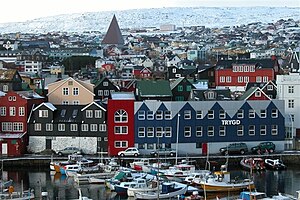Coonic Islands: Difference between revisions
(Created page with "{{Infobox country |native_name = |conventional_long_name = Republic of the Coonic Islands |common_name = Coonic Islands |image_flag = Flag_of_the_Greek_Orthodox_Church.svg |alt_flag = |national_motto = |national_anthem = |image_map = Coonic_Islands_Map.png |alt_map = |map_caption = |capital = M...") |
No edit summary |
||
| Line 92: | Line 92: | ||
The '''Republic of the Coonic Islands''', most commonly known as '''the Coonic Islands''', is an archipalegic nation located in the northern [[Samson Ocean]], separated from the mainland of [[Nortua]] by the [[Vyking Sea]]. The islands have a population of around 724,000 people, with around half concentrated in the capital and largest city of [[Malloe]], and the remaining population scattered across remote fishing towns. The terrain of the islands are rugged, and the subpolar oceanic climate is windy, wet, cloudy, and cool. Despite the northerly climate, the temperatures are moderated by warm ocean currents and average above freezing throughout the year, hovering around 12 °C (54 °F) in summer and 5 °C (41 °F) in winter. As a result of its northerly latitude, the islands experience perpetual civil twilight during summer nights and very short winter days. | The '''Republic of the Coonic Islands''', most commonly known as '''the Coonic Islands''', is an archipalegic nation located in the northern [[Samson Ocean]], separated from the mainland of [[Nortua]] by the [[Vyking Sea]]. The islands have a population of around 724,000 people, with around half concentrated in the capital and largest city of [[Malloe]], and the remaining population scattered across remote fishing towns. The terrain of the islands are rugged, and the subpolar oceanic climate is windy, wet, cloudy, and cool. Despite the northerly climate, the temperatures are moderated by warm ocean currents and average above freezing throughout the year, hovering around 12 °C (54 °F) in summer and 5 °C (41 °F) in winter. As a result of its northerly latitude, the islands experience perpetual civil twilight during summer nights and very short winter days. | ||
| Line 101: | Line 100: | ||
==Culture== | ==Culture== | ||
==Economy== | ==Economy== | ||
[[File:Eystaravág,_Torshavn,_faroe_islands,_feb_2005.jpg|thumb|right|A typical fishing town in the Coonic Islands]] | |||
Economic troubles caused by a collapse of the Coonic fishing industry in the early 1990s brought high unemployment rates of 10 to 15% by the mid-1990s. Unemployment decreased in the later 1990s, down to about 6% at the end of 1998. By June 2008 unemployment had declined to 1.1%. Nevertheless, the almost total dependence on fishing and fish farming means that the economy remains vulnerable. The biggest private companies of the Coonic Islands is the salmon farming company [[Connifrost]], one of the biggest in the world. | |||
[[Category:Coonic Islands]][[Category:Coalition of Crown Albatross]] | [[Category:Coonic Islands]][[Category:Coalition of Crown Albatross]] | ||
Revision as of 01:03, 11 November 2024
Republic of the Coonic Islands | |
|---|---|
|
Flag | |
 | |
| Capital and largest city | Malloe |
| Government | |
| Vejas Sukaitis | |
| Population | |
• 2024 estimate | 724,300 |
| Date format | mm-dd-yyyy |
The Republic of the Coonic Islands, most commonly known as the Coonic Islands, is an archipalegic nation located in the northern Samson Ocean, separated from the mainland of Nortua by the Vyking Sea. The islands have a population of around 724,000 people, with around half concentrated in the capital and largest city of Malloe, and the remaining population scattered across remote fishing towns. The terrain of the islands are rugged, and the subpolar oceanic climate is windy, wet, cloudy, and cool. Despite the northerly climate, the temperatures are moderated by warm ocean currents and average above freezing throughout the year, hovering around 12 °C (54 °F) in summer and 5 °C (41 °F) in winter. As a result of its northerly latitude, the islands experience perpetual civil twilight during summer nights and very short winter days.
History
Geography
Politics and government
Demographics
Culture
Economy
Economic troubles caused by a collapse of the Coonic fishing industry in the early 1990s brought high unemployment rates of 10 to 15% by the mid-1990s. Unemployment decreased in the later 1990s, down to about 6% at the end of 1998. By June 2008 unemployment had declined to 1.1%. Nevertheless, the almost total dependence on fishing and fish farming means that the economy remains vulnerable. The biggest private companies of the Coonic Islands is the salmon farming company Connifrost, one of the biggest in the world.
